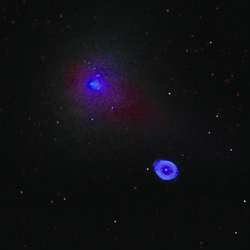
NASA’s Swift captured this image of 73P/Schwassmann-Wachmann 3 as it bypassed the Ring Nebula. Image credit: NASA. Click to enlarge
Comet 73P/Schwassmann-Wachmann 3 is visible in the night sky with even a small backyard telescope, and it will make its closest approach to Earth next week (don’t worry, it’s still really far away). One of the features of this comet, however, is that it’s unusually bright in the X-ray spectrum. Three X-ray observatories will observe the comet in the coming weeks to determine what it’s made of, and maybe even the composition of the solar wind that causes its tail.
Scientists using NASA’s Swift satellite have detected X-rays from a comet that is now passing the Earth and rapidly disintegrating on what could be its final orbit around the sun.
Swift’s observations provide a rare opportunity to investigate several ongoing mysteries about comets and our solar system, and hundreds of scientists have tuned in to the event.
The comet, called 73P/Schwassmann-Wachmann 3, is visible with even a small, backyard telescope. Peak brightness is expected next week, when it comes within 7.3 million miles of Earth, or about 30 times the distance to the Moon. There is no threat to Earth, however.
This is the brightest comet ever detected in X-rays. The comet is so close that astronomers are hoping to determine not only the composition of the comet but also of the solar wind. Scientists think that atomic particles that comprise the solar wind interact with comet material to produce X-rays, a theory that Swift might prove true.
Three world-class X-ray observatories now in orbit—NASA’s Chandra X-ray Observatory, the European-led XMM-Newton, and the Japanese-led Suzaku—will observe the comet in the coming weeks. Like a scout, Swift has provided information to these larger facilities about what to look for. This type of observation can only take place in the X-ray waveband.
“The Schwassmann-Wachmann comet is a comet like no other,” said Scott Porter of NASA’s Goddard Space Flight Center in Greenbelt, Md., part of the Swift observation team. “During its 1996 passage it broke apart. Now we are tracking about three dozen fragments. The X-rays being produced provide information never before revealed.”
The situation is reminiscent of the Deep Impact probe, which penetrated comet Tempel 1 about a year ago. This time, nature itself has broken the comet. Because Schwassmann-Wachmann 3 is much closer to both the Earth and the sun than Tempel 1 was, it currently appears about 20 times brighter in X-rays. Schwassmann-Wachmann 3 passes Earth about every five years. Scientists could not anticipate how bright it would become in X-rays this time around.
“The Swift observations are amazing,” said Greg Brown of Lawrence Livermore National Laboratory in Livermore, Calif., who led the proposal for Swift observation time. “Because we are viewing the comet in X-rays, we can see many unique features. The combined results of data from several premier orbiting observatories will be spectacular.”
Swift is primarily a gamma-ray burst detector. The satellite also has X-ray and ultraviolet/optical telescopes. Because of its burst-hunting ability to turn rapidly, Swift has been able to track the progress of the fast-moving Schwassmann-Wachmann 3 comet. Swift is the first observatory to simultaneously observe the comet in both ultraviolet light and X-rays. This cross comparison is crucial for testing theories about comets.
Swift and the other three X-ray observatories plan to combine forces to observe Schwassmann-Wachmann 3 closely. Through a technique called spectroscopy, scientists hope to determine the chemical structure of the comet. Already Swift has detected oxygen and hints of carbon. These elements are from the solar wind, not the comet.
Scientists think that X-rays are produced through a process called charge exchange, in which highly (and positively) charged particles from the sun that lack electrons steal electrons from chemicals in the comet. Typical comet material includes water, methane and carbon dioxide. Charge exchange is analogous to the tiny spark seen in static electricity, only at a far greater energy.
By comparing the ratio of X-ray energies emitted, scientists can determine the content of the solar wind and infer the content of the comet material. Swift, Chandra, XMM-Newton and Suzaku each provide complementary capabilities to nail down this tricky measurement. The combination of these observations will provide a time evolution of the X-ray emission of the comet as it navigates through our solar system.
Porter and his colleagues at Goddard and Lawrence Livermore tested the charge exchange theory in an earthbound laboratory in 2003. That experiment, at Livermore’s EBIT-I electron beam ion trap, produced a complex spectrograph of intensity versus X-ray energy for a variety of expected elements in the solar wind and comet. “We are anxious to compare nature’s laboratory to the one we created,” Porter said.
The German-led ROSAT mission, now decommissioned, was the first to detect X-rays from a comet, from Hyakutake in 1996. This was a great surprise. It took about five years before scientists had a suitable explanation for X-ray emission. Now, ten years after Hyakutake, scientists could settle the mystery.
Original Source: NASA News Release
